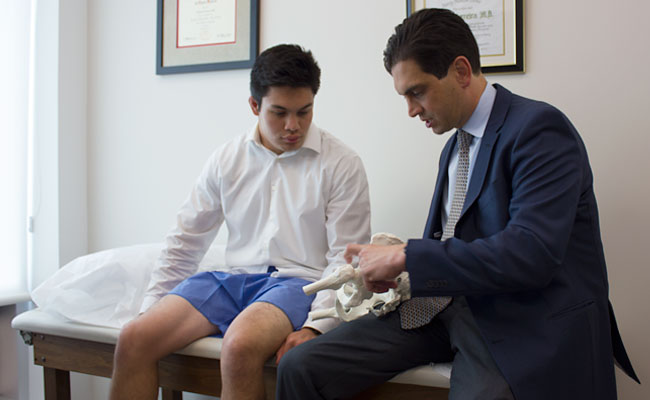
A board-certified arthroscopic surgeon specializing in young adult and adolescent hip preservation, and sports medicine, Dr. Dominic Carreira has created and shared a video demonstrating a detailed hip exam.
A key focus of this robust examination of the hip is to determine the exact location of the pain. Understanding that location, and the nature of the hip pain, enables the medical team to properly diagnose the underlying medical issue or cause.
Physical Examination of the Hip (Hip Exam)
In this video, Dr. Carreira demonstrates a physical examination of the hip. One of the challenges in diagnosis is isolating the hip from other sources of pain, such as the lumbar spine. Hip pain can present as anterior, lateral, or posterior pain, and typically joint pain is described as deep inside.
The hip exam as administered by Dr. Carreira includes the following tests:
- The straight leg raise (SLR) can differentiate between pain caused by a hip pathology such as a labral tear or FAI and back pathology such as a bulging or herniated disc. If the patient experiences a radiating pain along the sciatic nerve distribution during SLR, the patient may have a bulging or herniated disc.
- The FABER test, also called Patrick’s Test, is useful for differentiating hip pain from labral tears or FAI and SI joint dysfunction or tight hip abductors. If the patient experiences pain in the lower back area during FABER, it may be due to sacroiliac joint dysfunction.
- The FADIR test is used to identify pain caused by femoroacetabular impingement or FAI. If the patient experiences anterolateral pain during FADIR, this is indicative of FAI.
The most common cause of chronic hip pain in adolescents and young adults is labral tears, which in turn are commonly associated with femoroacetabular impingement (FAI).
If you’d like Dr. Carreira to examine your hip, please request an appointment with the appointment request form or call his office at 404-355-0743.


